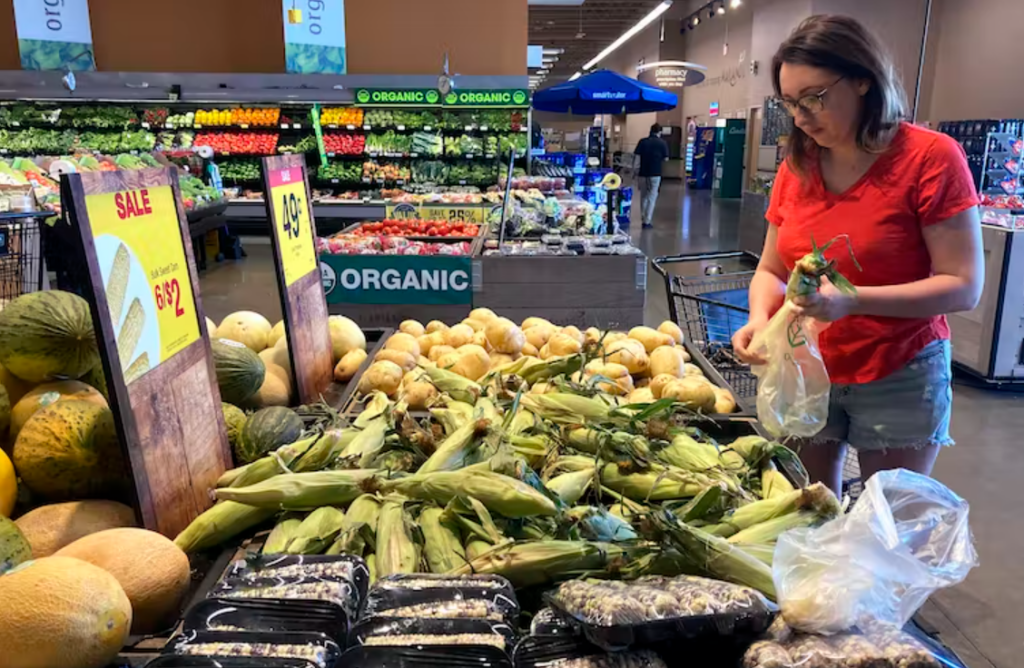Funding for federal food assistance fell while participation increased, report says

The U.S. government can’t do much about rising food prices, which are primarily caused by supply chain problems. (AP Photo/Nam Y. Huh)
Policy, politics and progressive commentary
A report on federal nutrition programs found that while government spending on food assistance programs decreased post-pandemic, participation in those programs has only grown, leaving more Americans than ever without access to the food they need.
Last week, the U.S. Department of Agriculture’s Economic Research Service released an annual report examining participation trends and spending for the agency’s largest domestic food and nutrition assistance programs.
The USDA spent around $166 billion on food and nutrition assistance programs in 2023, a 13% decrease in spending compared to the prior year, according to the Food and Nutrition Assistance Landscape annual report.
That decrease in federal spending was largely driven by cuts to the Supplemental Nutrition Assistance Program (SNAP) and other childhood nutrition programs, according to the report.
Federal spending on SNAP in 2023 decreased by nearly 6% compared to the previous year, even as participation in the program rose by about 2% nationally. Nearly 13% of the U.S. resident population participated in SNAP in an average month, the highest participation level since 2017.
In Nevada, SNAP participation increased by nearly 9% from 2022 to 2023, according to data tracked by the Nevada Division of Welfare and Supportive Services.
As of March, participation in SNAP in Nevada increased by about 3% compared to the same period last year.
Increases in participation could be related to inflation, according to the report. The Consumer Price Index for food, an indicator used to measure inflation, rose by nearly 6% in 2023. That’s down from food inflation of about 11% in 2022, but higher than inflation of about 4% percent in 2021.
Despite the increase in SNAP participation and inflation, the federal government cut the higher monthly emergency SNAP benefits awarded during the pandemic in 2023. On average, SNAP benefits have decreased by about 8% per household since the pandemic-era, according to the report.
In Nevada, a family of four receiving emergency SNAP benefits saw their benefits cut by an average of about 35%, or $334, in 2023, compared to 2022, according to the Nevada Division of Public and Behavioral Health.
By September 2023, the Pandemic Electronic Benefit Transfer (P-EBT) program — which reimbursed eligible families for missed school meals due to COVID-19-related school closures — was also eliminated.
Waivers allowing schools to serve free breakfast and lunch meals to all students through the National School Lunch Program and the School Breakfast Program were also eliminated by the fall of 2022, cutting federal spending on both programs by about 23% in 2023.
Only eight states chose to continue the free lunch program. Nevada’s Republican Gov. Joe Lombardo vetoed a bill in 2023 that would have provided universal free lunch for K-12 students in the state.
As a result, nearly 7% fewer lunches were provided to low-income students in 2023 compared to the previous year when the waiver was available. Additionally, about 9% fewer breakfast meals were served to food insecure students than when the waivers were available to schools, according to the report.
Data captured by the U.S. Census found that a growing share of households with school-aged children reported that paying for school meals made it difficult to pay for other expenses after pandemic waivers allowing schools to serve free meals to all students expired in 2022, according to the report.
One major food and nutrition program in the U.S. has maintained pandemic-era funding: the Special Supplemental Nutrition Program for Women, Infants, and Children (WIC).
In 2023, Congress extended the increase in monthly cash-value vouchers mothers could receive for fruit and vegetable purchases under the program. It was also the first year since 2009 that the number of infants participating in WIC increased, and the third consecutive year that participation increased among children.
It was a much needed benefit increase for mothers and young children, according to the report. Data revealed that food costs per person under WIC in 2023 averaged $55.95 per month, the highest cost per person since 2013 after adjusting for inflation.
All together, the federal government spent about 15% more on WIC than the previous year, reflecting an increase in participation and food costs.
The post Funding for federal food assistance fell while participation increased, report says appeared first on Nevada Current.

